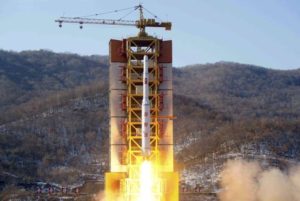
AP News:
North Korean space officials are hard at work on a five-year plan to put more advanced satellites into orbit by 2020, and don’t intend to stop there: They’re also aiming for the moon, and beyond.
In an interview with The Associated Press, a senior official at the North’s version of NASA said international sanctions won’t stop Pyongyang from launching more satellites by 2020, and that he hopes to see the North Korean flag on the moon within the next 10 years.
“Even though the U.S. and its allies try to block our space development, our aerospace scientists will conquer space and definitely plant the flag of the DPRK on the moon,” said Hyon Kwang Il, director of the scientific research department of North Korea’s National Aerospace Development Administration.
The North’s official name is the Democratic People’s Republic of Korea.
An unmanned, no-frills North Korean moon mission in the not-too-distant future isn’t as far-fetched as it might seem. Outside experts say it’s ambitious, but conceivable. While the U.S. is the only country to have conducted manned lunar missions, other nations have sent unmanned spacecraft there and have in that sense planted their flags.
“It would be a significant increase in technology, not one that is beyond them, but you have to debug each bit,” Jonathan McDowell, an astrophysicist at the Harvard-Smithsonian Center for Astrophysics who maintains an exhaustive blog on international satellites and satellite launches, said in an email to the AP.
Hyon said the current five-year plan, at the order of leader Kim Jong Un, focuses on launching more earth observation satellites and what would be its first geostationary communications satellite — which, technologically, would be a major step forward. He said universities are also expanding programs to train rocket scientists.
“We are planning to develop the earth observation satellites and to solve communications problems by developing geostationary satellites. All of this work will be the basis for the flight to the moon,” Hyon said July 28, adding that he personally would like to see that happen “within 10 years’ time.”
